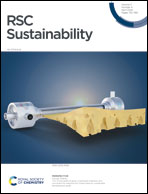Biomass-based ionic liquids efficiently catalyzed the cycloaddition reaction of epoxides with CO2 by hydrogen-bonding and the anion cooperative effect†
Abstract
Several novel biomass-based ionic liquids having hydroxyl derived from 5-hydroxymethylfurfural (5-HMF) were designed, synthesized, and applied to develop a single-component, multifunctional, and efficient catalytic system for the generation of cyclic carbonates from CO2 and epoxides. The system was suitable for the transformation of terminal and internal epoxides, providing a yield of up to 95%. A biomass-based ionic liquid ([5-HMFD–NMeEt2]I) exhibited excellent recyclability and stability, which was further proved by nuclear magnetic resonance (NMR) of the ionic liquid before and after use. Control experiments using catalysts with different functional groups indicated that the hydroxyl of the biomass-based ionic liquids had a hydrogen bonding effect and multifunctional groups such as hydroxyl and anions showed synergistic catalytic influences on the activation of the substrates. At the same time, the peak of the carbonyl in infrared (IR) spectra indicated that CO2 could be captured by the ionic liquid to promote the reaction.



 Please wait while we load your content...
Please wait while we load your content...